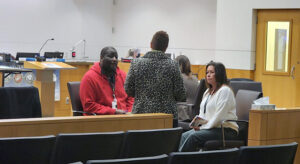The conversation on diversity + inclusion continues in the third episode of our Community Collaborative Series. In this episode, our community leaders tackle the barriers of bias inherent to many of the systems currently in place. Through their discussion, these community leaders provide a glimpse into the limits these biases create, as well as discuss ways to better address and overcome these systematic faults.
Community Collaborative co-host/producer and Black Chamber of Arizona CEO Robin Reed is back to take a deep dive into the limitations of hiring systems. When it comes to diversity and inclusion efforts in the workplace, it’s bigger than what’s happening within the walls of the workplace with current employees. He argues that the foundation of diversity and inclusion begins with the hiring and recruiting process. Despite the push and desire for diversity and inclusion in the workplace, the hiring process that many organizations follow— including recruiting, retaining and promoting— have biases. Reed highlights the need for removing biases from this process altogether in order to reach the first step toward equal opportunity as part of diversity and inclusion efforts.
In reference to conversations from earlier episodes, Reed quotes his co-host, and Arizona Hispanic Chamber of Commerce CEO Monica Villalobos when touching on the objective behind the discussions around Diversity and Inclusion. He reiterates Villalobos’s stance of “know[ing] it may have to begin as an initiative where you have to put a lot of focus on it and a lot of effort into it, but eventually want[ing] it to become so much a part of [a business’s] DNA, like breathing. Like thinking. Then you don’t have to have these additional efforts in place.”
Joining Reed on this episode are Debbie Esparza, CEO of YWCA Metropolitan Phoenix, and Tim Overton, Dickinson Wright PLLC attorney and appointed member of the Arizona Commission of African American Affairs.
Reed, Esparza and Overton dive into two questions all companies should consider when evaluating the systems in place at all levels of their organization:
– What do these systems currently in play look like and how are they responding to bias?
– How can we change these existing systems?
Don't Miss These Highlights
Reed and Debbie Esparza share (4:18) insight on the power of learning to understand perspective when communicating with others, weighing in on the role listening plays when it comes to respecting differing viewpoints. When it comes to systematic bias, looking beyond the bias of one’s own experience plays an imperative role in paving the way for diversity and inclusion to become part of a new, improved system.
Esparza continues to emphasize there is no right or wrong way to approach diversity and inclusion (6:05). All that matters is that efforts are being made to address systems that block equal opportunity. Esparza looks to the YWCA’s diversity and inclusion initiatives Pledge to Stand Against Racism (6:45) and Theater of the Oppressed (25:28) to help shed light on issues stemming from bias such as wage gaps and systematic inconsistencies.
She goes on to recognize the complications that arise when a system that has been in place for so long goes unquestioned. Esparza hints at the need to question these systems in order to identify the inequalities that stem from them. While many people who benefit from these systems take their inherent advantages for granted, there is a need to acknowledge the fact that, for many others, these systems create barriers of oppression and inequality. Therefore, she urges leaders to build a new habit of looking at the systems to better identify, understand and correct the biases in these systems.
Tim Overton joins in to highlight the importance of bringing belonging to the conversation (12:40) when breaking down systematic bias. He notes it is not enough to just bring in diverse employees (13:35), but argues in favor of promoting them within the company to solidify a culture of inclusion and belonging.
Bringing diversity, inclusion and belonging into the workplace is often stunted by biases. Overton illustrates implicit bias by referring to several studies and statistics, including a study done by MIT and University of Chicago (14:10), revealing candidates with white-sounding names on resumes were invited to 50 percent more interviews compared to identical resumes with names assumed to belong to someone of a racial or ethnic minority. He brings attention to the reality that the implicit biases in our systems far surpass obvious biases, emphasizing the need to closely look at the systems in place.
If you’re ready to take the next step in your action plan, click here to watch our breakout episode with Tim Overton that provides action-based solutions to diversity and inclusion challenges within Arizona’s business landscape.
Actions Organizations Should Take
Important takeaways from Episode 3 include:
- – Question the systems currently in place
- – Review the hiring and recruiting process; Scan for barriers created by bias
- – Use artificial intelligence (1:45) to help remove, or at least minimize, bias from the hiring process
- – Encourage and celebrate unique lived experiences as a way to create acceptance of differing perspectives; Recognize how they add to the DNA of a business (6:15)
- – Engage in intelligent and open conversation (10:10) to help people understand the position different from their own
- – Create buy-in (13:10) to promote increased and authentic participation in D&I efforts
- – Look for bias across the entire hiring system, including recruiting, hiring and promoting (13:26)
- – Address systematic biases by recognizing, defining and controlling them (15:06)
- – Help control bias during the hiring process; Consider removal of certain aspects of a resume (such as names and zip codes) that are not important to the work that is going to be done (15:32)
- – Learn about lesser-known biases that may be preventing quality candidates from getting hired (bias based on pedigree, hair color, height, weight, social media presence, etc.)
- Shift toward a model of pay based on qualification and performance (23:52) to decrease wage gaps
- – Improve inclusion by listening and speaking without judgment (30:49)
- – Improve diverse representations in leadership positions to prevent any one person from carrying the burden of representing a whole population (35:10)
- – Engage in conversations about bias
While many leaders and organizations are eager to implement diversity and inclusion, the conversation from today’s Community Collaborative reminds us that we must first look at the limitations holding us back. Before an organization can increase its D&I efforts, it is imperative to take a step back to recognize and address the hurdles created by organizational and societal systems. While these conversations can be hard, it is the first step to coming out on the other side.
About The Community Collaborative
Community and business leaders and individuals who want to educate themselves on diversity issues will find the series informative and educational. And anyone who wishes to get involved will have ready access to resources featured in each program.
The video series may be streamed for free through the STN app. Viewers may subscribe through STN’s website or by downloading the STN app on the App Store or Google Play.
Each program in the series will provide details on how to get involved in featured activities and initiatives. To be featured in “The Community Collaborative” series or other STN programming, contact us at 480.967.7088.
Every day, there are leaders on the front lines of the fight to improve life in our community. STN provides the platform to tell their and their communities’ stories with video series on leadership philosophies and active efforts to make positive change in our region.





